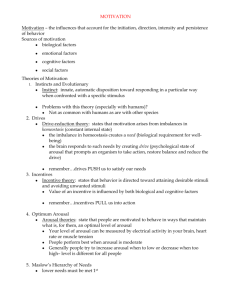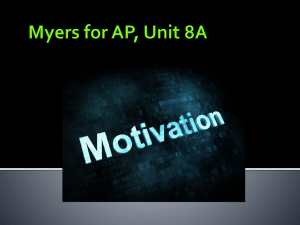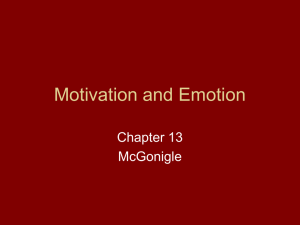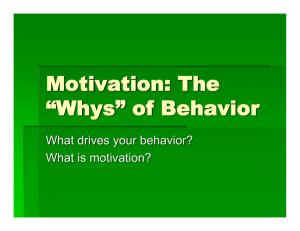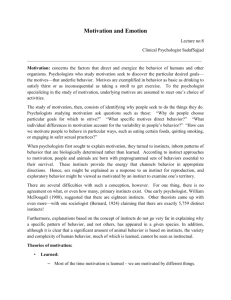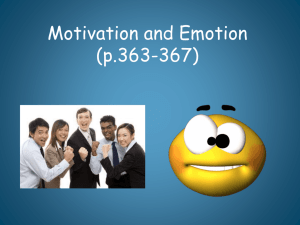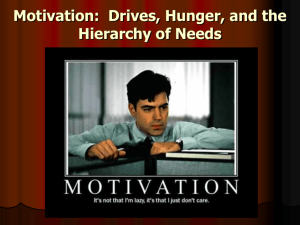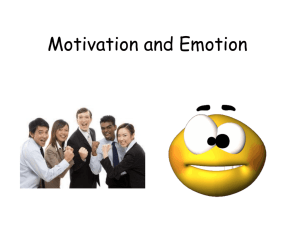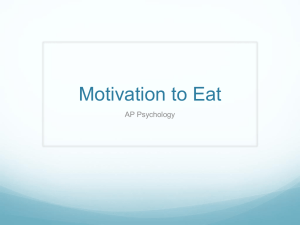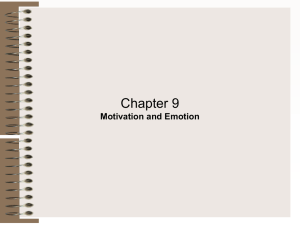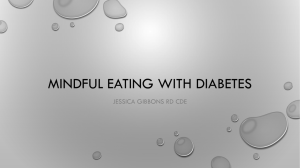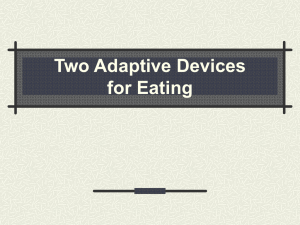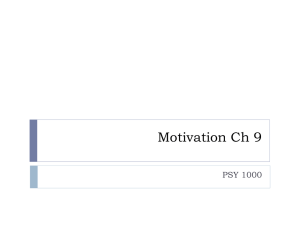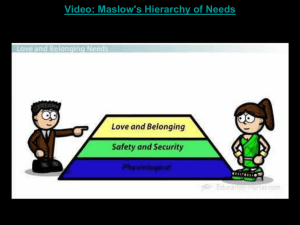Ciccarelli Chapter 9 - Motivation and Emotion
advertisement
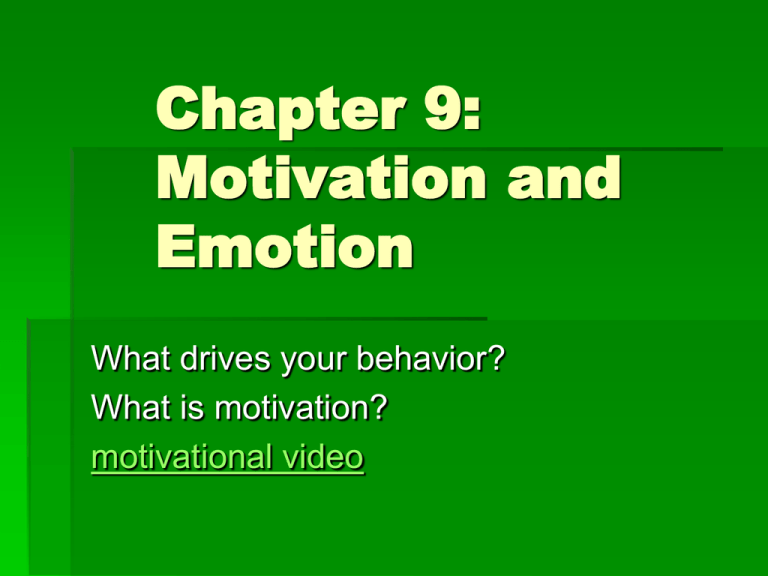
Chapter 9: Motivation and Emotion What drives your behavior? What is motivation? motivational video Understanding Motivation Motivation refers to factors that activate, _________, arouses, and sustain goal-directed behavior. Motives are the “whys” of behavior - the needs or wants that drive behavior and explain why we do what we do. What’s your motive for seeking a higher education??? There are different types of motivations. Sometimes a person is driven to do something because of an external reward or the avoidance of an unpleasant consequence. This is called ‘extrinsic motivation’, because the performance of that action leads to an outcome that is separate from or external to the person. Understanding Motivation ________________ is the motivation in which a person performs an action because the act itself is ____________ or satisfying in some internal manner. Biologically determined and innate patterns of behavior that are unlearned in the presence of certain stimuli is called ______________. Instinctive behaviors are genetically programmed, innate patterns of response that are specific to members of a particular species. According to instinct approach theorists, our motivation is governed by innate patterns of behaviors similar to animals. Drive-Reduction Approaches A______________ is a requirement of some material that is essential for survival. Having a need leads to: 1) psychological tension, as well as, 2) a physical arousal that motivates the organism to act in order to fulfill the need and reduce the tension. This tension is called a drive. Drive theory is the belief that behavior is motivated by drives that arise from biological needs that demand satisfaction. Drive-reduction theory A __________________ - Is a state of deprivation or deficiency. A Drive is a state of bodily tension, such as hunger or thirst, that arises from an ____________ need. The satisfaction of a drive is called drive reduction. _________________________ proposes that there is a connection between internal physiological states and outward behavior. Primary drives are innate drives, such as hunger, thirst, and sexual desire, that arise from basic biological needs; something you are born with. Acquired (secondary) drives are drives that are learned or acquired through experience, or conditioning such as the drive to achieve monetary wealth. Drive theory is based on the principle of homeostasis, the tendency of the body to maintain a steady internal state. Psychological Needs Psychologist David McClelland (1961, 1987) proposes a theory of motivation based on psychological needs: achievement, affiliation, and ________________. The need for achievement involves a strong desire to succeed in attaining challenging goals and to receive feedback on their accomplishment. The need for affiliation is a need for friendly social interactions and relationships with others; and to be held in high regard by those around them. Popularity rules. Psychological Needs The need for Power, is the need to have control over people; to have high status and prestige. Personality and nAch: Carol Dweck’s Self-theory of motivation – The need for achievement is closely linked to personality factors, including a person’s view of how self can affect the understanding of how much a person’s actions can influence his or her success. Self is defined as the beliefs one holds about one’s abilities and relationships to others. Persons who have and internal locus of control tend to achieve more than those who operate from a external locus of control. Value the _________________ process. Need for stimulation – Another explanation for human motivation Stimulus motives are internal states (unlearned) that prompt inquisitive, stimulation-seeking, and exploratory behavior. Arousal theory states that whenever the level of stimulation dips below an organism’s optimal level, the organism seeks out stimulation. People have an ideal level of tension that pushes them to achieve. The relationship between arousal and task performance generally takes the form of an inverted Ushaped curve. This relationship is known as the Yerkes-Dodson Law which states that people perform best under conditions of ____________arousal. Need for Stimulation _______________ refers to the person that needs more arousal than the average person. Psychological factors that are included in motivation includes: incentives, cognitive dissonance, and psychosocial needs. Incentive theory has the belief that our attraction to particular goals or objects motivates much of our behavior. Incentives are rewards or other stimuli that motivate us to act; that lures us into action; that pulls us to our goal. Is your goal pulling you or are you pulling it??? Incentives _______________ is when behavior is explained in terms of the external stimulus and its rewarding properties. The rewarding properties exist independently of any ___________ or _________________ and can cause people to act only upon the incentive. Expectancy-value theories are incentive theories that assume the actions of humans cannot be ____________ or fully understood without understanding the beliefs, values, and the importance that a person attaches to those beliefs and values at any given moment in time. Incentives Many theorists see motivation as a combination of both the “push” of internal needs or drives and the “pull” of a rewarding external stimulus. Humanistic Approaches: Maslow’s Hierarchy of Needs – According to Maslow, ___________________ is the point that is seldom reached at which people have satisfied the lower needs and achieved their full human potential. Peak experiences are the times in a person’s life during which self-actualization is temporarily achieved. Abraham Maslow’s Hierarchy of Needs (1) Physiological needs: Hunger, thirst, avoidance of pain, sexual gratification, elimination. (2) Safety needs: Safe and secure housing, protection from crime and harsh weather. (3) Love and Belongingness needs: Emotional intimacy, friendships, social connections. (4) Esteem needs: Achievement, respect, prestige, status, approval. Maslow’s Hierarchy of Needs (5) Cognitive needs: To know, understand, and explore. (6) Aesthetic needs: To appreciate symmetry, order, and beauty. (7) Self-Actualization needs: Fulfillment of individual potential. (8) Transcendence needs: To help others achieve self-actualization. ___________________________ – Is a theory of human motivation in which the social context of an action has an effect on the type of motivation existing for the action. Self-determination theory In this theory, there are three inborn and universal needs that help people gain a complete sense of self and whole, healthy relationships with others. The three needs are autonomy (being in control of one’s own behavior and goals), competence (the need to be able to master the challenging tasks of one’s life), and __________________ ( The need to feel a sense of belonging, intimacy, and security in relationships with others). What happens in the body to cause hunger? Hunger occurs when our blood sugar level drops and fat is released from fat cells to provide fuel that cells use until we are able to eat again. _______________ and glucagons are hormones secreted by the pancreas to control the levels of fats, proteins, and carbohydrates in the body. Insulin ________________ the level of glucose in the bloodstream, while glucagons increases the level. The hypothalamus has two separate areas that are controlled by the levels of glucose and insulin in the body, which appears to control eating behavior; the ventromedial hypothalamus (VMH) and the lateral hypothalamus (LH). Animals whose ventromedial hypothalamus was damaged would no longer stop eating. It appears that the signal of being full was no longer being received. The lateral hypothalamus seems to influence the onset of eating when insulin levels go up. Damage to this area caused the animals to stop eating to the point of starvation. Weight Set Point and Basal Metabolic Rate Researchers believe that the hypothalamus affects the particular level of weight that the body tries to maintain, called ________________________. The basal metabolic rate is the number of calories your body burns at rest to maintain normal body more functions. Social Components of Hunger - Sometimes people eat from habit than from need. And sometimes people eat when they are not really hungry. Sometimes a persons eating habit is derived from their culture, and maybe because they are depressed, or because they are classically conditioned to eat at a certain time of the day, e.g. 5pm is dinner. Hunger and Eating Lateral hypothalamus is apart of the hypothalamus involved in initiating , or turning on eating. Stimulating the lateral hypothalamus causes a laboratory animal to start eating even if it has just consumed a full meal. Or if it is surgically removed, the animal will stop eating and starve to death. Ventromedial hypothalamus, acts as an off-switch that signals when it is time to stop eating. When this area is destroyed, animals will overeat and eventually become severely obese. Dopamine and endorphins, appear to be responsible for the feelings of pleasure associated with eating. Whereas, serotonin appears to play a role in regulating our feelings of satiety, the sensations associated with having had enough to eat. Maladaptive Eating Problems Obesity is a state of excess body fat; a condition in which the body weight of a person is 20% or more over the ideal body weight for that person’s weight. These persons are at risk for developing life-threatening diseases including heart disease, hypertension, severe respiratory disorders, stroke, and diabetes. It is believed that obesity is on the rise due to two main factors: too many calories consumed and too little exercise. Factors that contribute to Obesity: (1) Early behavioral dietary patterns, e.g., rewarded with sweets; (2) Environmental factors, e.g., TV commercials displaying tempting foods; (3) Emotional states, e.g., anger, fear, an depression can prompt excessive eating. (4) Genetics (5) Leptin – is a protein that is secreted as a hormone by the fatty tissues of the body. Leptin signals the ________________ that the body has had enough food, reducing appetite and increasing the feeling of being full, or satiated. The Biology of Obesity Anorexia Nervosa – Is a form of _______________ that results in an unhealthy and potentially dangerously low body weight; a condition in which a person reduces eating to the point that a weight loss of 15% below the ideal body weight or more occurs. It is characterized by both an intense fear of becoming fat and a distorted body image. Bulimia Nervosa – Is a disorder in which episodes of binge eating are followed by purging. Eating disorders are far less common, even rare, in non-Western countries. The Three Elements of Emotions Emotions infuse our lives with color. Researchers say that emotions are more than just feelings; they have physiological (bodily arousal/nervous system activation), cognitive (subjective experience of the feeling, as well as the thoughts or judgments we have about the people or situations that evoke the feelings), and behavioral components (outward expression of the emotion). Emotional Expression Cross-cultural studies show that people from many different cultures can accurately identify six basic emotions from facial expressions: anger, fear, disgust, sadness, happiness, surprise, and contempt. Display rules are learned ways of controlling displays of emotion in _____________________; it governs cultural customs and norms that govern the display of emotional expressions, e.g., Asian cultures tend to frown on the public display of emotions. Theories of Emotions The Common Sense Theory of Emotion states - a stimulus leads to an emotion of fear, which then leads to bodily arousal through the autonomic nervous system. James-Lange Theory holds the belief that emotions occur after people become aware of their physiological responses to the triggering stimuli. You run then you are fearful. Cannon-Bard Theory argues that emotional and physiological reactions to triggering stimuli occur almost simultaneously. Schachter-Singer (Cognitive Arousal Theory) States that experiencing fear involve both the physical arousal and the labeling of that arousal based on cues from the environment must occur before the emotion is experienced. Smile, You’ll Feel Better Facial-feedback hypothesis assumes that facial expressions provide feedback to the brain concerning the emotion being expressed, which in turn causes and intensifies the emotion in you; that mimicking facial movements associated with a particular emotion will produce the corresponding emotional state. Lazarus’s Cognitive-Mediational Theory of Emotion argues that a stimulus causes an immediate appraisal. The cognitive appraisal results in an emotional response, which is then followed by the appropriate bodily response. Positive Psychology Movement Social Psychologist David G. Myers argues that people should focus on their strengths, wellbeing, and the pursuit of happiness. He list 10 suggestions for becoming happier: 1) Realize that enduring happiness doesn’t come from success, 2) Take control of your time, 3) Act happy, 4) Seek work and leisure activities that engage your skills, 5) Join the “movement” movement, 6) Give your body the sleep that it wants, 7) Give priority to close relationships, 8) Focus beyond the self, 9) Keep a gratitude journal, and 10) Nurture your spiritual self. Positive Psychology Martin Seligman list a number of suggestion to help people increase their personal happiness: 1) Gratitude visits - do something for someone else; 2) Three Blessings – every night, think of three things that went well during the day and reflect on them. 3) Savoring – Plan a perfect day and share it with someone. Happiness is not so much a function of what you’ve got as what you make of it. The End Study Study Study
